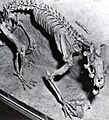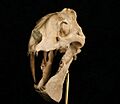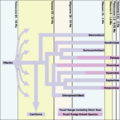Feliforms facts for kids
Feliformia is a group of mammals that are mostly cat-like. It's a special group, or suborder, within the larger Carnivora order, which includes all meat-eating mammals. This suborder includes all the true cats, like your domestic cat, tigers, and lions. It also includes their close relatives, such as hyaenas, civets, and mongooses.
Today, there are six main families within the Feliformia suborder. These families contain many different types of animals, with a total of 114 species. Scientists use DNA studies to understand how these animals are related. They've found that all Feliformia animals share a common ancestor. The other main group of carnivores is the dog-like Caniformia.
Quick facts for kids FeliformiaTemporal range: Eocene to Recent
|
|
|---|---|
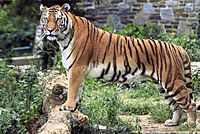 |
|
| Tiger (Panthera tigris) | |
| Scientific classification | |
| Kingdom: | |
| Phylum: | |
| Class: | |
| Order: | |
| Suborder: |
Feliformia
Kretzoi, 1945
|
Cat-like Families Today
There are seven main families of Feliformia living today. They live all over the world, except in Australia and Antarctica. Most of these animals are good at climbing trees or spend a lot of time in them. They are often ambush hunters, meaning they hide and wait for their prey. What they eat depends on their size. Bigger species usually hunt small mammals. Smaller species might eat insects or other small creatures without backbones.
Here's a quick look at each family:
Eupleridae: The Malagasy Carnivores
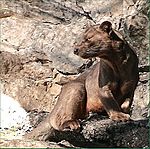
The family Eupleridae is special because all its members live only on the island of Madagascar. This family includes animals like the fossa, falanouc, Malagasy civet, and Malagasy mongooses. There are eight species in this family. They look very different from each other. Because of their varied looks, people used to think they were related to different animals on the mainland. For example, some were thought to be civets or mongooses.
These animals come in many shapes and sizes. Some are very small, weighing less than 500 grams (1 pound). Others can be quite large, up to 12 kilograms (26 pounds). Some, like the fossa, have claws that can be pulled back, similar to cats. Others, like the falanouc, do not. Most have slender bodies and pointed noses, except for the fossa, which has a blunt snout. Their diet also varies. They can eat small mammals, insects, crabs, or snails.
Felidae: The True Cats

The family Felidae includes all the well-known "cat-like" carnivores. This means your domestic cat, tigers, lions, and ocelots are all part of this family. There are 41 species of true cats alive today. Most of them have claws that can be pulled back into their paws. You can find cats on every continent except Australia (where domestic cats were brought by people) and Antarctica.
Cats range greatly in size. The tiny black-footed cat weighs only about 2 kilograms (4.5 pounds). The huge tiger can weigh up to 300 kilograms (660 pounds)! Their diet also varies depending on their size. They can hunt large mammals, small mammals, birds, or even insects.
Hyaenidae: Hyenas and Aardwolves

The family Hyaenidae includes hyenas and the aardwolf. There are four species in this family. They have some features that are similar to dogs, even though they are cat-like carnivores. For example, their claws cannot be pulled back, and they have long snouts. They are also good at running long distances. You can find them in the Middle East, India, and Africa.
Hyenas are large and powerful animals. Some can weigh up to 80 kilograms (176 pounds). They are very successful hunters and scavengers. The aardwolf is much smaller, weighing about 27 kilograms (60 pounds). It has a special diet, mainly eating termites.
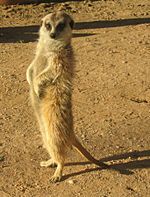
Herpestidae: Mongooses and Meerkats
The family Herpestidae includes the mongooses, kusimanses, and meerkats. There are 32 species in this family. In the past, these animals were grouped with civets. But scientists later found that mongooses are different enough to be in their own family. They live in Africa, the Middle East, and Asia. All mongooses have claws that cannot be pulled back.
They are generally smaller animals, ranging from 1 kilogram (2.2 pounds) to 5 kilograms (11 pounds). They usually have long, slender bodies and short legs. Their diet changes based on the species and what food is available. They can eat small mammals, birds, reptiles, insects, and crabs. Some species are omnivores, meaning they also eat fruits and plant roots.
Nandiniidae: The African Palm Civet
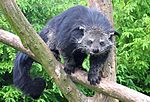
The family Nandiniidae has only one species: the African palm civet (Nandinia binotata). It lives across sub-Saharan Africa. This animal has claws that can be pulled back. It has a slender body and lives in trees. It's an omnivore, meaning it eats both plants and animals, with a lot of fruit in its diet. African palm civets are relatively small. The larger males can weigh up to 5 kilograms (11 pounds).
Prionodontidae: The Asiatic Linsangs
The family Prionodontidae includes the two species of Asiatic linsang. They live in Southeast Asia. These animals are very good at climbing trees and mostly eat meat. They are the closest living relatives to the true cats (family Felidae).
Viverridae: Civets, Genets, and Binturongs
The family Viverridae includes animals like the binturong, other civets, genets, and the African linsang. There are 30 species in this family, and all of them have claws that can be pulled back. They live in Southern Europe, Africa, and Asia.
Their size varies from 500 grams (1 pound) to medium-sized carnivores weighing up to 14 kilograms (39 pounds). They have long bodies and short legs, and usually long tails. Some even have tails that can grasp things, like the binturong. Their diet includes small mammals, insects, crustaceans, and molluscs. Many species, like the binturong, also eat plants.
Evolution of Feliforms
About 60 million years ago, during a time called the Middle Paleocene, a group of animals called Miacoidea appeared. These were small, tree-dwelling carnivores. They were probably about the size of mongooses and likely ate insects, small mammals, and birds. They had teeth that were starting to look like the special meat-cutting teeth (called carnassials) that carnivores have today.
Around 42 million years ago, in the Middle Eocene period, the Miacoids started to split into two main groups of carnivores: the Feliforms (cat-like) and the Caniforms (dog-like). The early Feliforms stayed in forests. They continued to be tree-dwelling or partly tree-dwelling hunters who waited to ambush their prey. The early Caniforms, however, became more active and hunted in open areas.
It's clear that the first Feliforms appeared around this time. However, it's hard to find a clear common ancestor for all the Feliform families in the fossil record. This is because forest environments don't preserve fossils as well as other places. This means there are big gaps in what we know from fossils.
To learn more about how Feliforms and Caniforms evolved, you can look at articles on Carnivora, Miacoidea, and Carnivoramorpha.
Images for kids
See also
 In Spanish: Feliformia para niños
In Spanish: Feliformia para niños





